CD Biosynsis is a leading expert that dedicated to providing a wide range of enzyme design services for a long time. We specialize in providing AI-guided enzyme design services to industries seeking innovative solutions and enhanced enzymatic processes.
Overview
AI-guided enzyme design models can predict potential enzyme candidates for validation, thereby greatly accelerating the process of enzyme engineering and design. These enzyme design models are especially useful while dealing with large datasets and complex relationships between enzyme structure, substrate properties, and catalytic function.
 Fig. 1 Boost-RS framework for enzyme–substrate recommendation prediction. (Li X., et al., 2022)
Fig. 1 Boost-RS framework for enzyme–substrate recommendation prediction. (Li X., et al., 2022)
Our Services
To predict the enzyme-substrate interaction through AI-guide enzyme design models, our EnzymoGenius™ platform perform the following procedures to develop useful AI models.
- Data Collection
The first step is to collect a database set for known enzyme-substrate interactions, which includes information about enzyme structure, substrate structure and details of the catalytic mechanism.
- Feature Extraction
In the context of enzyme design, key features could include information about chemical properties of amino acids in the enzyme active site, substrate properties, and structural features of the enzyme and substrate.
- Model Training
During AI model training, the model learns to recognize patterns and relationships between input features and corresponding enzyme-substrate interactions.
- Validation and Testing
Trained models are validated and tested on different datasets to ensure that they can generalize to new and unseen data.
- Prediction
Once trained and validated, the AI model can be used to predict enzyme-substrate interactions for new or hypothetical substrates.
Advantages & Applications
- High Throughput Screening
Through high-throughput screening of large datasets, AI models are able to quickly identify the vast chemical space of substrates and predict potential interactions between enzymes and substrates.
- Efficient Exploration of Design Space
AI models can efficiently navigate the enzyme design process in a space containing many complex variables while considering multiple factors to develop more effective design strategies.
- Prediction of Novel Enzyme-Substrate Pairs
AI models have the ability to predict new enzyme-substrate interactions that may not be immediately evident based on existing knowledge, which may help us discover enzymes with unique catalytic activity or expanded substrate specificity.
- Time and Cost Savings
By reducing the need for extensive experimental screening, AI-guided enzyme design models save time and resources. Predictions from the model can guide experimental efforts towards the most promising candidates, minimizing trial-and-error approaches.
- Insights into Catalytic Mechanisms
AI models can provide insights into the underlying catalytic mechanisms by identifying key features and interactions between enzymes and substrates, helping us to guide rational design strategies and deepen our understanding of enzymatic reactions.
In summary, AI-guided enzyme design models provide a powerful and efficient method for exploring the vast space of enzyme-substrate interactions, offering invaluable insights for a wide variety of applications in biotechnology, medicine, and industry.
CD Biosynsis has a professional scientific research team that dedicated to providing enzyme directed evolution and design services. Combining our strengths in artificial intelligence field applications, we use AI to guide enzyme design and predict enzyme-substrate interactions. If you are interested in our services for enzyme designing, please do not hesitate to contact us.
Reference
- Li, X.; et al. Boost-RS: boosted embeddings for recommender systems and its application to enzyme-substrate interaction prediction. Bioinformatics. 2022. 38(10):2832-2838.

































 Fig. 1 Boost-RS framework for enzyme–substrate recommendation prediction. (Li X., et al., 2022)
Fig. 1 Boost-RS framework for enzyme–substrate recommendation prediction. (Li X., et al., 2022)